Menus
- A comparison of mid-range naked bikes
- Mid-range naked bikes
- PS_Measured values and driving performance
- PS data
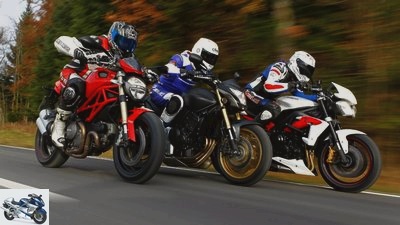

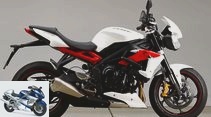
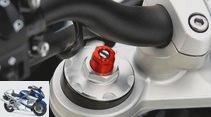
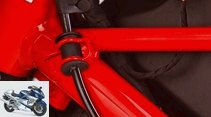
17th photos
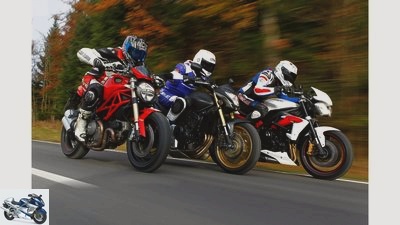
1/17
The Triumph Street Triple R, Honda Hornet 600 and the Ducati Monster 1100 Evo compete against each other. Which of them is the best gateway drug?
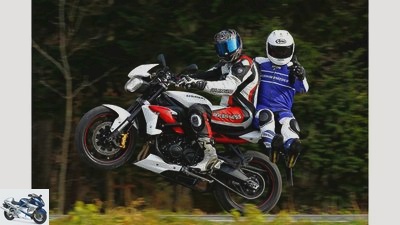
2/17
The overall package of the Triumph Street Triple R is quite simply one of the best on the market.
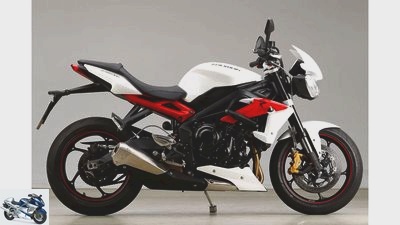
3/17
The Streety is the great success model in this sector and was freshly revised.
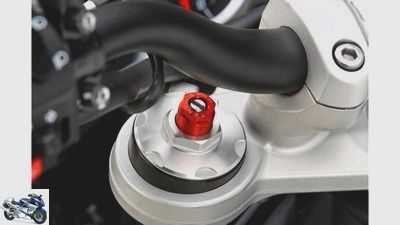
4/17
Unfortunately, the rebound damping at the fork can hardly be achieved on the Street Triple R..
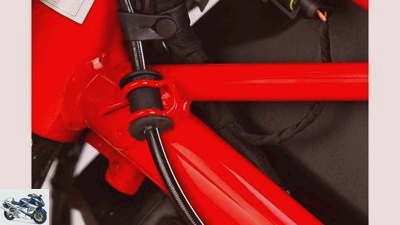
5/17
The aesthetes like welded cable holders.
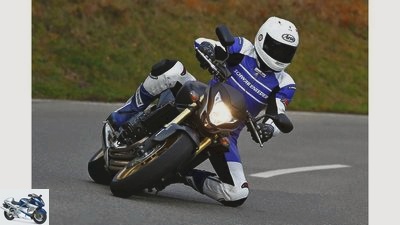
6/17
The Honda Hornet 600 is a good but listless motorcycle.
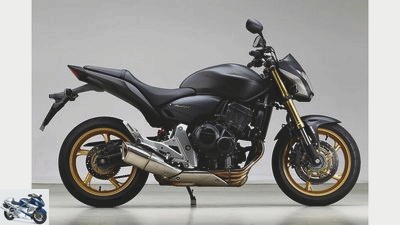
7/17
The days of throttled SSP engines are over, if you want to be ahead of the Nakeds, you need torque.
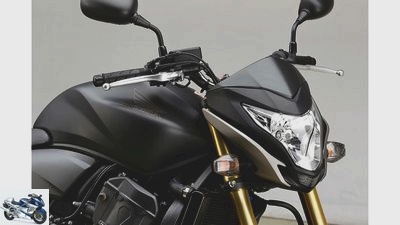
8/17
The hornet is more of an honest man than an arsonist. Their sporty look promises more dynamism than is served.
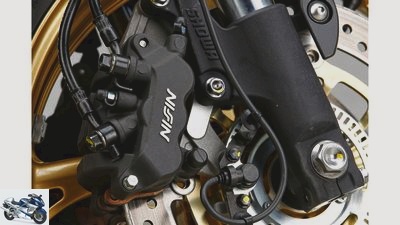
9/17
We liked the C-ABS, but the overall design of the Hornet 600 is too conservative.
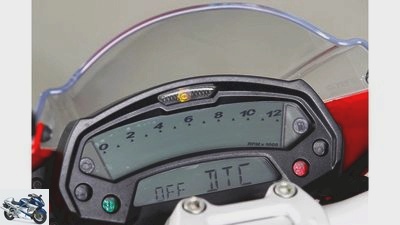
10/17
The Monster is a character performer. Their good assistance systems can be switched off, which the play children enjoy.
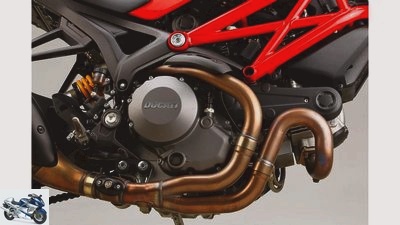
11/17
The fat manifolds on the air cooler of the Monster 1100 Evo.
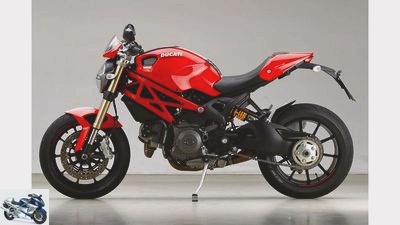
12/17
As with the Triumph, character and individuality pay off beyond the point rating – through ardent fans.
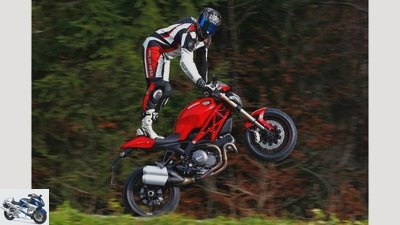
13/17
Ducati Monster 1100 Evo: The beau from Italy has rough edges that have to please you.
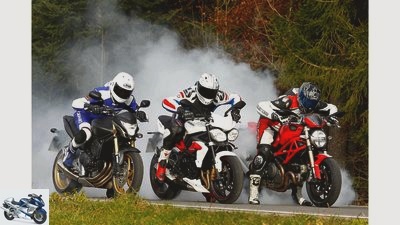
14/17
Left to right: Honda Hornet 600, Triumph Street Triple R and Ducati Monster 1100 Evo.
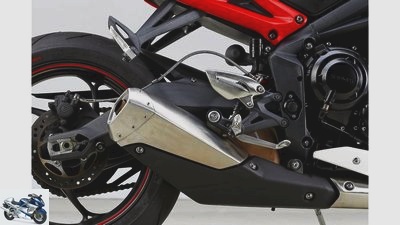
15/17
The new exhaust is very reminiscent of the Honda Hornet.

16/17
A firm and adjustable chassis like the Streety is rare in the middle class.

17/17
The manifolds promise a lot more. What a pity.
Comparison test: Triumph Street Triple R, Honda Hornet 600 and Ducati Monster 1100 Evo
A comparison of mid-range naked bikes
Content of
Crampons are indispensable up to the top of icy mountains. Our three naked bikes may not be indispensable, but when their front wheels rise into the sky – who wants to climb icy mountains? PS tests the Triumph Street Triple R, Honda Hornet 600 and Ducati Monster 1100 Evo.
Mid-range naked bikes
E.t is ultimately always a question of character and taste. Motorcycling is an emotional thing and much more than just any way of getting from A to B. Motorcycling is a voluntary pastime, serves as an escape from everyday life or to compensate for stress – it is simply a great hobby. The way to this topic is as complex as the human being. Bare mid-range bikes often act as entry drugs, which is why it makes sense to equip even these mostly cheap motorcycles with distinctive characteristics.
Buy complete article
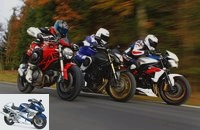
Comparison test: Triumph Street Triple R, Honda Hornet 600 and Ducati Monster 1100 Evo
A comparison of mid-range naked bikes
Ducati Monster 1100 Evo too. It is not the cheapest monster, but as a twin it can keep up with the other two candidates in the comparison test.
The overall package of the Triumph Street Triple R is quite simply one of the best on the market.
How do the characters of the three middle-graders look like? The easiest way to explain this is with a wheelie picture that we have produced together. The Ducati, with its large-volume, air / oil-cooled two-cylinder, has to be put on the rear wheel in first gear at a low speed of around 3000 tours with just pulling the handlebars and a little sugar on the clutch lever. This is followed by a stable ride until the power curve flattens out very early, which forces you to shift up with the front wheel raised. The Hornet with its castrated CBR 600 RR engine, on the other hand, needs higher speeds if it is to be on the rear wheel. As a result, even before the front lifts off, it is always faster than the Ducati with its wheel raised. If the Honda is on the rear wheel, it continues to accelerate rapidly. To prevent this, you have to drive closer to the tipping point and with the rear brake – so the Hornet is steeper than the Duc at the same speed. And the Street Triple R? Well, it doesn’t wheelt quite as voluntarily and light-footedly as the old model, but basically it still wheezes best everywhere.
Its robust three-cylinder, which apart from a slightly longer first gear and a more economical mapping of the injection system has been taken over unchanged from its predecessor, is still a formidable source of joy. He has no problem putting the 188 kilo Streety on the rear wheel in almost all life and speed situations. When it comes to lifting the front wheel of all three at the same time, it becomes difficult even for experienced PS testers. But well, driving a wheelie isn’t everything.
The Honda Hornet 600 is a good but listless motorcycle.
Apart from the unicycle acrobatics, the different engine characteristics also have an effect on the driving pleasure of the three naked people and have a lasting impact on them. And then there is a strong applause from the Honda – just no applause. The Ex-CBR 600 RR engine was throttled with difficulty for use in a naked bike. The result is an aggregate that acts very cautiously up to 9000 tours, which has been noticeably robbed of its super sports performance. Vibrations across the entire engine speed range are just as annoying as the severely limited engine speed range when chasing country roads. If the Hornet does not want to lose touch with Duc and Triumph, its smoothly working gearbox has to be operated very often. The Hornet only gets in the right mood when it leads the group of three. Only when driving freely, when the pilot himself selects the cornering speed, gear and engine speed and does not have these parameters imposed by others, does it generate the dynamics that its appearance promises. But if the driver in front dictates the speed and thus the speed range, you are often lost with the Honda. No lard in the lower speed range and the narrow usable speed range then harbor a considerable potential for frustration.
Sadly, the displacement gnome and displacement giant of this test share the annoyance of the narrow usable speed range. If the Honda only goes around the top, the Duc only really pushes hard between 3000 and 6000 revolutions. Above that, it goes more slowly up to 7500 rpm before the joy of revving disappears completely. Anyone who thinks that the mighty twin first tears up the asphalt out of the hairpin bends and then leaves the competition behind is wrong. A rather long secondary translation slows down the monsters, which even gives it the worst pull-through values in the test field. Like the Honda, the monsters in sport mode have to be moved with a lot of manual work. With the big difference that neither her gear nor the operating force of her clutch can achieve the flexibility and lightness of the Japanese. If you always let the monsters run nicely on a winding route, a nice flow will set in very quickly. In contrast to the Honda foursome, it doesn’t annoy you with the hellish screaming of five-digit speeds, but rather massages the body and soul of the pilot (and the environment) with thick, soothing bass beats. It should also be mentioned that with the Ducati Safety Pack, the M 1100 Evo is the only one with traction control in its luggage. If this is at the level of the least control intervention, Duc and rider can only be slowed down by a tank light flashing early when surfing the bass wave.
Ducati Monster 1100 Evo: The beau from Italy has rough edges that have to please you.
Even faster than on the Ducati, the Triumph rider gets into the aforementioned flow, i.e. that state of mind that decouples us from everyday life and in which full concentration is limited to driving. “Becoming one with the motorcycle” is what connoisseurs call this. Their mixture of grumpy intake noise, propulsion in all positions, good throttle response and agile turning ability immediately raptures. If you want to stroll, the Briton simply lets it roll at low speed, if you want to burn, simply turn the gears off to the limiter. But be careful! Whoever sees wind will reap a storm. At least the heart of the pilot takes the Streety by storm. In contrast, even the crisp, almost stubborn gear or the most pronounced load changes in the test field can hardly do anything. The start, the sound, the joie de vivre of the triple are just too euphoric. And so that the vitality of the triplet can be fully savored, Triumph did not save on the chassis either. Like its two competitors, the Streety likes soft springs, but not only has fully adjustable spring elements, but also crisp damping reserves. Sporty and tight, it burns up and away, preferring to give away some driving comfort than leaving the pilot in the vague no man’s land of a too soft tuning without feedback.
archive
The setup of the naked bikes on the country road.
However, the dampers of the Streety should respond more sensitively. The fact that the fork occasionally bottomed out when braking on bumps is due to the soft springs already mentioned. But Duc and Honda hit the end stops of their forks harder and more often in sporting use. Both are very soft in the front, probably to minimize kickback tendencies. Corrections via the compression damping are not possible, at least on the Honda, and only to a limited extent on the Monster. The Hornet has no compression adjustment, the adjustment range of the Ducati is too small here. A very similar picture on the struts. Tight but not optimally appealing that the Triumph, too soft and with too little reserves that the Honda. Ducati’s Monoshock works passably and, like that of the Honda, does not need a deflection. The balance of the Hornet is once again noticeable as sensational. The synchronicity with which the fork and shock absorber handle waves and bumps is great. Unfortunately, the setup that is too soft costs accuracy and stability in an inclined position, so that the great balance cannot be implemented in cornering speed.
We liked the C-ABS, but the overall design of the Hornet 600 is too conservative.
The handling of the Hornet is an absolute surprise, especially in slow alternating curves. Here, despite its narrow handlebars, the equally agile Triumph pulls the skin over its ears. And the Duc? The Monster is certainly not a stubborn or unwieldy motorcycle, but it is powerless against these two bustling dervishes. And what about the brakes? To start with, all three braking systems are working at a high level. The Ducati offers a very good ABS that can be switched off, but could significantly increase the dosage. An initially long empty path leads to a strong bite. This compresses the soft fork violently, which is why the braking feeling suffers a lot. After all, there is never a risk of falling because the ABS regulates late. The Honda combi brake is convincing on country roads, especially in autumnal conditions. The rear wheel, which brakes with the front wheel brake, ensures great braking stability and a very safe feeling. At the moment the triple comes without ABS (available from February 2013 for an additional charge of 400 euros). Like its predecessor, with its degressive braking effect, it first bites in a sporty way and then demands more manual force for constant braking. This can overwhelm beginners in particular and lead to a locking front wheel in the event of panic braking. So the brake (without ABS) is the only real point of criticism of the new Street Triple R. Hey, but ABS will be available from February, and: Who is perfect? Who’s perfect?
PS judgment
Triumph Street Triple R:
Another victory that was won with confidence. The Streety is still the boss in the area, its overall package is simply one of the best on the market.
Ducati Monster 1100 Evo:
The beau from Italy has rough edges that you have to please. As with the Triumph, character and individuality pay off beyond the point rating – through ardent fans.
Honda Hornet 600:
The Hornet is a good but listless motorcycle. The days of throttled SSP engines are over, if you want to be at the front of the Nakeds, you need torque.
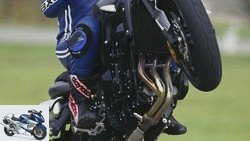
motorcycles
Test: Triumph Street Triple R
Mr. R
read more
PS_Measured values and driving performance
archive
PS measurements of the three naked bikes.
The performance curves couldn’t show the conceptual advantage of the three-cylinder more clearly. While the two-cylinder displacement giant, the Ducati, generates fat torque early on, but lacks torque, the Honda doesn’t pull sausage off its plate up to 9000 tours and only really starts then. The triple of the Triumph may not have the punch of the twin, but it does combine an early maximum torque with torque and top performance. He is a dream.
Performance
| Acceleration** | Draft | Top speed * | ||||
| 0-100 km / h | 0-150 km / h | 0-200 km / h | 50.100 km / h | 100-150 km / h | ||
| Ducati Monster 1100 Evo | 3.6 s | 6.8 s | 14.6 s | 6.9 s | 6.1 s | 225 km / h |
| Honda Hornet 600 | 3.5 s | 63.8 s | 15.2 s | 5.1 s | 7.2 s | 230 km / h |
| Triumph Street Triple R. | 3.5 s | 6.6 s | 12.9 s | 4.7 s | 5.1 s | 226 km / h |
* Manufacturer’s information, ** PS measured values
PS data
Left to right: Honda Hornet 600, Triumph Street Triple R and Ducati Monster 1100 Evo.
Ducati Monster 1100 Evo
Drive:
Two-cylinder 90-degree V-engine, two valves / cylinder, 70 kW (95 PS) at 7500 / min *, 105 Nm at 6000 / min *, 1079 cm³, bore / stroke: 98.0 / 71.5 mm , Compression ratio: 11.3: 1, ignition / injection system, 45 mm throttle valves, hydraulically operated multi-disc oil bath anti-hopping clutch, six-speed gearbox, G-Kat, chain, traction control
Chassis: Steel tubular space frame with screwed cast aluminum parts, steering head angle: 66.0 degrees, caster: 94 mm, wheelbase: 1450 mm, upside-down fork, Ø fork inner tube: 43 mm, adjustable in spring base, rebound and compression level. Central spring strut without deflection, adjustable in spring base and rebound. Suspension travel front / rear: 130/148 mm
Wheels and brakes: light alloy cast wheels, 3.50 x 17 / 5.50 x 17, front tires: 120/70 ZR 17, rear: 180/55 ZR 17, first tires: Pirelli Diablo Rosso II, 320 mm double disc brakes with four-piston fixed calipers at the front , 245 mm single disc with two-piston fixed caliper at the rear, ABS
Measurements and weight:
Length / width / height: 2090/950/1130 mm *, seat / handlebar height: 800/980 mm, handlebar width: 735 mm, 189 kg fully fueled, v./h .: 50.4 / 49.6%
Rear wheel power in last gear:
67 kW (91 PS) at 208 km / h
Consumption:
Fuel type: Super unleaded. Average test consumption: 7.6 liters / 100 km, tank capacity 13.5 liters, range: 178 km
Base price:
11690 Euro (plus ancillary costs)
Honda Hornet 600
Drive:
Four-cylinder in-line engine, four valves / cylinder, 75 kW (102 PS) at 12000 / min *, 64 Nm at 10 500 / min *, 599 cm³, bore / stroke: 67.0 / 42.5 mm, compression ratio: 12, 0: 1, ignition / injection system, 36 mm throttle valves, mechanically operated multi-plate oil bath clutch, six-speed gearbox, G-Kat, chain
Landing gear:
Light alloy central tube frame, steering head angle: 65.0 degrees, caster: 99 mm, wheelbase: 1435 mm, upside-down fork, Ø fork inner tube: 41 mm, adjustable spring base and rebound damping. Central spring strut without deflection, adjustable in spring base and rebound damping. Suspension travel front / rear: 120/128 mm
Wheels and brakes
Cast light alloy wheels, 3.50 x 17 / 5.50 x 17, front tires: 120/70 ZR 17, rear: 180/55 ZR 17, initial tires: Bridgestone BT 012 “J”, 296 mm double disc brake with three-piston floating caliper at the front, 240 -mm-single disc with single-piston floating caliper at the rear, C-ABS
Measurements and weight:
Length / width / height: 2010/790/1210 mm *, seat / handlebar height: 810/1010 mm, handlebar width: 680 mm, 207 kg with a full tank, v./h .: 49.5 / 50.5%
Rear wheel power in last gear:
68 kW (92 PS) at 215 km / h
Consumption:
Fuel type: Super unleaded. Average test consumption: 7.6 liters / 100 km, tank capacity 19 liters, range: 250 km
Base price:
8590 euros (plus ancillary costs)
Triumph Street Triple R.
Drive:
Three-cylinder in-line engine, four valves / cylinder, 78 kW (106 HP) at 11850 / min *, 68 Nm at 9750 / min *, 675 cm³, bore / stroke: 74.0 / 52.3 mm, compression ratio: 12.7 : 1, ignition / injection system, 44 mm throttle valves, mechanically operated multi-plate oil bath clutch, six-speed gearbox, G-Kat, chain
Landing gear:
Light alloy bridge frame, steering head angle: 65.9 degrees, caster: 95 mm, wheelbase: 1410 mm, upside-down fork, Ø fork inner tube: 41 mm, adjustable spring base, rebound and compression. Central spring strut with deflection, adjustable in spring base, rebound and compression. Suspension travel front / rear: 115/135 mm
Wheels and brakes:
Cast light alloy wheels, 3.50 x 17 / 5.50 x 17, front tires: 120/70 ZR 17, rear: 180/55 ZR 17, first tires: Pirelli Diablo Rosso Corsa, 310 mm double disc brakes with radially attached four-piston fixed calipers at the front, 220 -mm single disc with single-piston floating caliper at the rear
measurements and weight
Length / width / height: 2080/900/1200 mm *, seat / handlebar height: 820/1000 mm, handlebar width: 725 mm, 188 kg fully fueled, v./h .: 52.0 / 48.0%
Rear wheel power last gear:
73 kW (99 PS) at 214 km / h
Consumption:
Fuel type: Super unleaded. Average test consumption: 7.7 liters / 100 km, tank capacity 17.4 liters, range: 226 km
Base price:
9,090 euros (plus additional costs, test machine price due to accessories 9,93 euros)

motorcycles
Test: Triumph Street Triple R
Mr. R
read more
Related articles
-
Ducati Monster 821, Suzuki GSX-S 750, Triumph Street Triple RS
34 pictures 1/34 Three motorcycles, three drive concepts. Ducati Monster 821, Suzuki GSX-S 750 and Triumph Street Triple RS in …
-
Comparison test Honda Hornet 600 ABS, Kawasaki Z 750 ABS and Triumph Street Triple
Artist comparison test Honda Hornet 600 ABS, Kawasaki Z 750 ABS and Triumph Street Triple Weekend Warriors Life is almost sterile. Engines…
-
35 pictures 1/35 BMW S 1000 R, Ducati Monster 1200 S, KTM 1290 Super Duke R and Triumph Speed Triple R in comparison …
-
Jahn 19th photos Jahn 1/19 11,200 euros have to be raised for this fascinating motorcycle. But you get a two-year guarantee, as well as an equally long…
-
Comparison test all-rounder Honda Hornet 900, Triumph Speed Triple, Yamaha FZS 1000 Fazer
Comparison test of all-rounders Honda Hornet 900, Triumph Speed Triple, Yamaha FZS 1000 Fazer Free radicals Undisguised, light and strong: Honda Hornet 900 ….
-
Comparison test: MV Agusta Brutale 675 and Triumph Street Triple
fact 15 pictures fact 1/15 The MV Agusta Brutale 675 attacks the Triumph Street Triple in the middle class sector of naked bikes. fact 2/15 The Street …
-
Triumph Street Triple R old versus new in the top test
Jahn 18th photos Jahn 1/18 Stefan Kaschel and Karsten Schwers in conversation. fact 2/18 All good: The Nissin system is still convincing, rims with red…
-
Comparison test: Honda CB 1000 R, Yamaha FZ1, Triumph Speed Triple, Kawasaki Z 1000
Comparison test: Honda CB 1000 R, Yamaha FZ1, Triumph Speed Triple, Kawasaki Z 1000 Large naked bikes in comparison Contents of …
-
Comparison test Ducati 996 S, Honda CBR 900 RR, Triumph Daytona 955i
PhotoGargolov comparison test Ducati 996 S, Honda CBR 900 RR, Triumph Daytona 955i Strategy games Four wins? Or would you rather be quick with three? …
-
Comparison test Ducati 916 Biposto, Honda CBR 900 RR and Triumph Daytona T 595
Comparison test Ducati 916 Biposto, Honda CBR 900 RR and Triumph Daytona T 595 Fire and flame It had to be that way. Everyone wrote it, everyone …